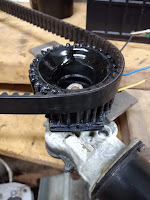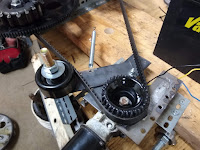May 13, 2020
The very first “real world” test drive/road test has been completed, successfully!!! This is a major milestone for the PIE. This first road test was done with no instrumentation installed in the subject vehicle, so there is no empirical data for the record. I also did not install a remote switch or camera.
The next round of testing needs to include vehicle data recording instrumentation and the ability to turn the PIE on and off remotely from the cab.
Conditions:
Ambient temp; 40 deg. F.
Subject vehicle; 2005 Chevrolet Colorado, 4WD, Crew Cab
Power Source; 12v lead acid battery
Connection; Alligator clip wires direct from motor to battery
Mounting; Fastened to a wood pallet in truck bed, pushing on front of bed, tied down with strap
Direction of Travel; Predominantly North/South with up to 3.5 miles of East/West
Terrain: Paved highways with some hills with grades up to 5% & one gravel lane-way approx. 1000’ long
Speed: City speeds/traffic 0-30 mph, Suburban 40 mph, Rural 45 to 55 mph
Total distance traveled: 13.2 miles
Observations were as follows:
Discernible pulsing/surging in the forward direction at ALL speeds (0 to 60mph)
Noise much louder when stopped but lessening with vehicle speed
Not very discernible during normal to hard acceleration
Very noticeable during “coast down”, coming to a stop and under gentle acceleration
A good analogy would be someone pushing the vehicle with one foot (like a skateboarder) from behind using just one hand on the vehicle.
The Set Up:
Vehicle mounting was kept as simple as possible, yet safety was always a very real concern.
The PIE was very simply screwed to a wooden pallet with deck screws. The pallet was modified to fit the truck bed of my subject vehicle properly.
Braces were placed at the front of the pallet so that the forward push is placed on the front of the bed (under the toolbox) and a strap was placed at the rear to keep the PIE/pallet assembly from lifting or shifting (sliding is not a big concern as the bet has a rubberized liner).
A simple 3-sided plywood box covering was made to keep debris and weather from directly affecting the PIE (good thing I did this, since we just had a freak May snowstorm) but the ends were left open for access & visibility (imagine the questions a police officer might have otherwise).




















